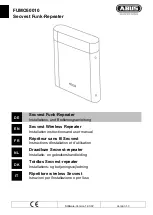
Kerosene/Paraffin Forced Air Heater Quick-Start Guide
KEROSENE/PARAFFIN FORCED AIR HEATER
QUICK-START GUIDE
Thank you for purchasing a STANLEY forced air heater. Please keep your User’s Manual for future reference and
seasonal servicing recommendations.
For optimal performance, STANLEY recommends that K-1 kerosene/paraffin be used, especially in temperatures
lower than -
3
°C (2
6
°F). If K-1 kerosene/paraffin is not available, these other fuels may be used: #1/#2 diesel/fuel oil,
JET A, or JP-8. Never use “off road” diesel, fuel additives, or fuel alternatives.
How to Get Your New Heater Quickly Up and Running
1. Familiarize yourself with all safety instructions in the front of your User’s Manual.
2. Remove the heater from the box. Ensure all parts are included and assemble per the instructions.
3. Remove any protective material applied to the heater for shipment.
4. Check the heater for damage. If damage is found, contact the service partner.
5. Before filling the fuel tank for the first time, remove any moisture or condensation.
6. When filling the fuel tank, use at least 8 liters (2 gallons) of fuel. Ensure the heater is on a level surface and do not
overfill. Ensure the fuel cap is tightened.
7. Plug in the heater to a minimum 1.8 m (6-foot), 0.75 mm
2
(ST-45-KFA-E and ST-70T-KFA-E models) or 1.5 mm
2
(ST-
125T-KFA-E - ST-215T-KFA-E models), 3-prong grounded extension cord.
8. Turn on the heater, and set the temperature controller higher than the ambient temperature. A few seconds after
the fan starts running, the heater will ignite. Only use this heater in a well-ventilated outdoor space!
• NOTE:
Smoke or flames may be briefly seen from the end of the heater after being turned on for the first time.
Louder than normal noise from the unit, as well as a hot smell, should subside after a few minutes of initial operation.
9. If needed, you can adjust the pump pressure to get the heater to run at maximum efficiency.
Due to varying fuel consistencies and changes in elevation, the fuel pump may require a simple adjustment. This will
get your heater working at an optimum level. You will need a screwdriver and your User’s Manual.
If any of the following scenarios happen after the first few minutes of initial operation, turn off the heater, unplug it,
and wait for the heat to subside.
Problem
Possible Cause
Solution
The heater does not
have a consistent flame
or will not stay lit.
Pump pressure is
too low
With a screwdriver, turn the pump adjustment screw
clockwise to increase pump pressure.
The heater produces
smoke and sputters
out fuel.
Pump pressure is
too low
With a screwdriver, turn the pump adjustment screw
clockwise to increase pump pressure.
A flame extends out of
the front of the heater.
Pump pressure is
too high
With a screwdriver, turn the pump adjustment screw
counter-clockwise to decrease pump pressure.
For continued difficulties or items not covered here, see the Troubleshooting Guide in the User’s Manual.
STK
B
-43
6
Decrease
Pressure
Increase
Pressure
Pump Adjustment
Screw
This is an unvented portable heater. It uses air (oxygen) from the area in which it is used. Adequate combustion and
ventilation air must be provided. Please read the User’s Manual very carefully and understand all warning statements.
The manual has been designed to instruct you on the proper operation, maintenance, and storage of your new heater.
© 201
8
Stanley Black & Decker, Inc.
Pinnacle Climate Technologies, Inc.
Sauk Rapids, MN 56379 USA
EC REP
© 2017 Obelis S.A
Registered Address:
Bd. Général Wahis, 53, 1030 Brussels, Belgium






















